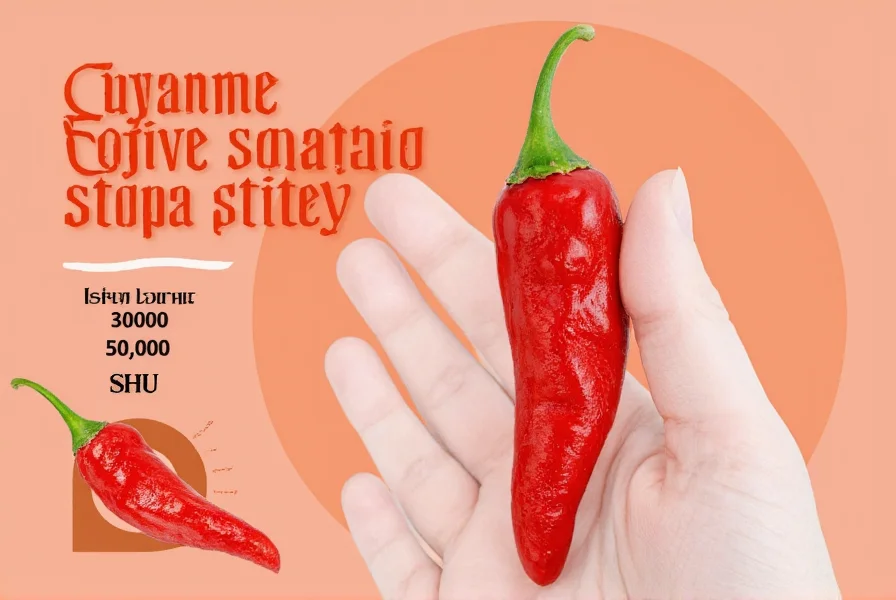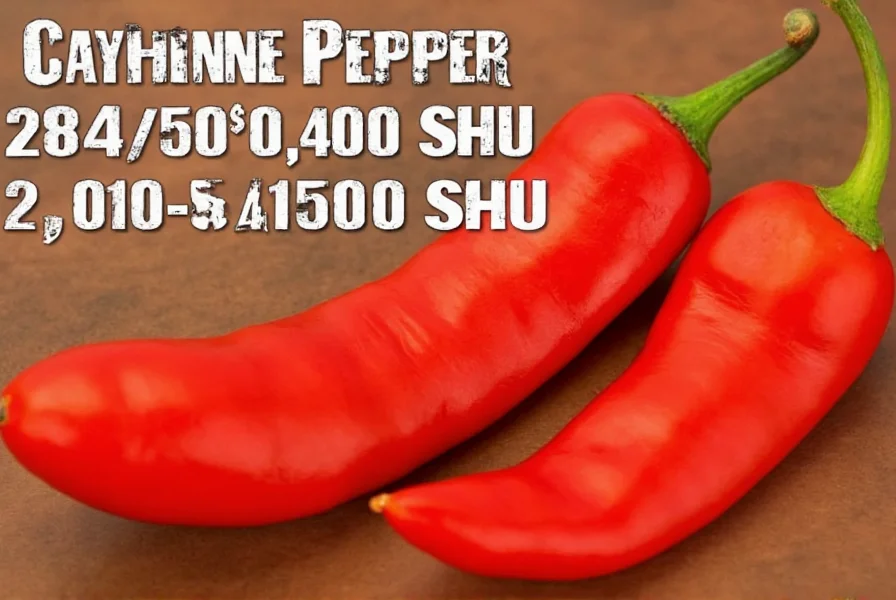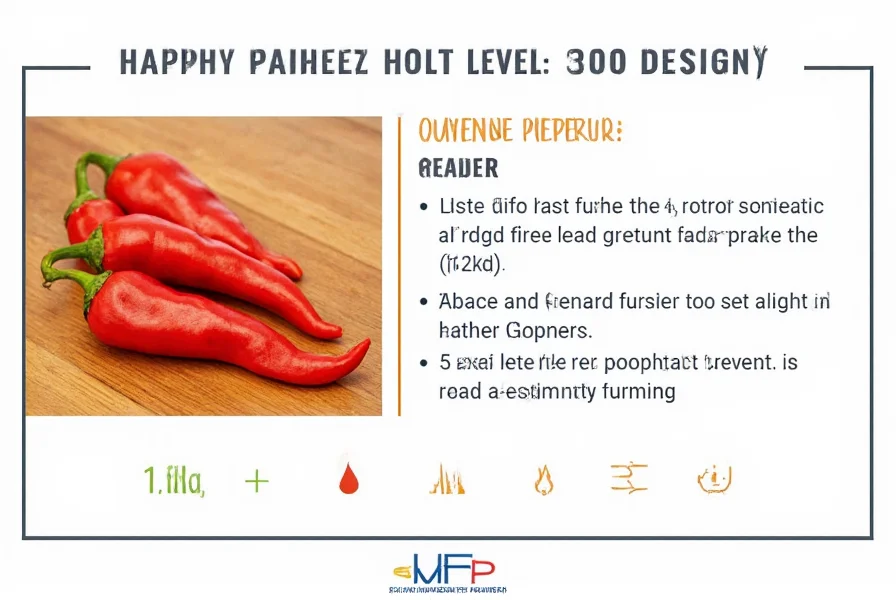Understanding exactly how spicy is cayenne pepper requires context about heat measurement and practical implications for cooking. The Scoville scale, developed by pharmacist Wilbur Scoville in 1912, remains the standard for measuring chili pepper heat intensity through capsaicin concentration.
Decoding the Scoville Scale for Cayenne Pepper
The Scoville Organoleptic Test originally relied on human taste panels diluting pepper extract until heat became undetectable. Today, high-performance liquid chromatography (HPLC) provides precise capsaicinoid measurements, converted to Scoville units for consumer understanding.
When evaluating how hot cayenne pepper really is, consider these key reference points:
| Pepper Variety | Scoville Heat Units (SHU) | Relative Heat Comparison |
|---|---|---|
| Bell Pepper | 0 SHU | 0 times hotter than cayenne |
| Jalapeño | 2,500-8,000 SHU | 4-12 times milder than cayenne |
| Cayenne Pepper | 30,000-50,000 SHU | Baseline for comparison |
| Tabasco Sauce | 2,500-5,000 SHU | 6-20 times milder than cayenne |
| Habanero | 100,000-350,000 SHU | 2-11 times hotter than cayenne |
Factors Influencing Cayenne Pepper Heat Levels
Several variables affect the actual heat you experience when using cayenne:
- Growing conditions - Soil composition, climate, and water stress significantly impact capsaicin production
- Varietal differences - Some cayenne cultivars naturally produce more capsaicin than others
- Processing methods - Drying concentrates heat, while vinegar-based preparations may slightly reduce perceived spiciness
- Part of the pepper used - Seeds and inner membranes contain the highest capsaicin concentrations
When determining how spicy is cayenne pepper in practical terms, remember that individual heat tolerance varies dramatically. What seems moderately hot to an experienced chili eater might feel extremely spicy to someone with lower tolerance.

Practical Applications of Cayenne's Heat Level
Understanding cayenne's position on the heat scale helps in several culinary contexts:
Cooking with Cayenne Pepper
Chefs value cayenne for its consistent heat and clean, sharp flavor profile. Unlike some hotter peppers that introduce complex fruity notes, cayenne delivers straightforward heat that enhances rather than dominates dishes. When substituting cayenne for other peppers:
- Replace 1 fresh cayenne with 3-4 jalapeños for equivalent heat
- Use 1/8 teaspoon cayenne powder for each fresh cayenne called for in recipes
- Start with half the recommended amount and adjust to taste, especially when cooking for mixed-heat-tolerance groups
Safety Considerations with Cayenne
While not among the world's hottest peppers, cayenne's heat level requires proper handling:
- Wear gloves when handling fresh cayenne peppers to prevent skin irritation
- Avoid touching your face, especially eyes, after handling
- Use dairy products (milk, yogurt) rather than water to alleviate mouth burn
- Store cayenne powder in airtight containers away from moisture

Health Implications of Cayenne's Heat
The capsaicin responsible for cayenne's heat offers several potential health benefits when consumed in moderation:
- May temporarily boost metabolism and support weight management efforts
- Shows anti-inflammatory properties in scientific studies
- Can improve circulation when consumed regularly
- Often used in topical pain relief preparations
However, individuals with sensitive digestive systems should monitor their intake, as excessive consumption may cause gastrointestinal discomfort. Understanding exactly how spicy is cayenne pepper helps determine appropriate serving sizes for your personal tolerance.
Conclusion: Understanding Cayenne's Place in the Pepper Spectrum
Cayenne pepper's 30,000-50,000 SHU rating makes it a versatile heat source in global cuisines. It provides significant spice without overwhelming other flavors, distinguishing it from both mild peppers like poblanos and extreme varieties like ghost peppers. When working with cayenne, always remember that freshness, preparation method, and individual tolerance affect the perceived heat level. Whether you're exploring how hot cayenne pepper compares to other spices or determining appropriate usage in recipes, this medium-hot pepper remains a kitchen staple for good reason.
Frequently Asked Questions
How does cayenne pepper compare to red pepper flakes in heat level?
Cayenne pepper typically measures 30,000-50,000 SHU, while commercial red pepper flakes usually range from 500-5,000 SHU. Most red pepper flakes contain a blend of milder peppers, making pure cayenne significantly hotter. One teaspoon of cayenne generally equals 3-4 teaspoons of standard red pepper flakes in heat intensity.
Can I substitute cayenne for paprika in recipes?
Yes, but with caution. Standard paprika measures 500-1,000 SHU while cayenne is 30,000-50,000 SHU. Use only 1/8 to 1/4 teaspoon of cayenne for each tablespoon of paprika called for in a recipe. For smoked paprika substitutions, consider adding a pinch of cumin to approximate the flavor profile.
Why does some cayenne pepper seem hotter than others?
Natural variation in capsaicin content occurs due to growing conditions, plant genetics, and processing methods. Sun exposure, soil nutrients, and water stress during growth all affect heat levels. Additionally, some commercial products blend cayenne with hotter peppers like habanero, creating "extra hot" versions that exceed the standard 30,000-50,000 SHU range.
How much cayenne pepper is too much in cooking?
For most home cooks, 1/8 to 1/4 teaspoon of cayenne per serving provides noticeable heat without overwhelming other flavors. Exceeding 1/2 teaspoon per serving typically creates uncomfortably hot dishes for average palates. Always add cayenne gradually, tasting as you go, since you cannot reduce heat once added to a dish.











 浙公网安备
33010002000092号
浙公网安备
33010002000092号 浙B2-20120091-4
浙B2-20120091-4